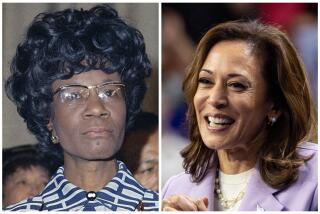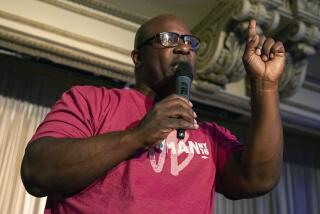Nader Vote May Cast His Name in History
MILWAUKEE — Ralph Nader a spoiler?
Maybe. But if you want a real spoiler, check out Teddy Roosevelt, whose renegade Bull Moose Party split the Republican presidential vote in 1912 and put Democrat Woodrow Wilson in the White House. Or George C. Wallace, whose 1968 American Independent campaign may have helped Republican Richard Nixon’s ascension to power.
Third-party presidential candidates historically attract little attention and even less voter support. But sometimes, the right candidate riding the right issue can vault a third party to the front of the national political stage. Texas businessman Ross Perot ranted about budget deficits and racked up 19% of the vote in the 1992 election.
Nader’s campaign, however, stands as an anomaly in American politics. Nationally he’s struggling to grab 5% of the popular vote, within the usual vote range of minor candidates. But the election itself is so tight, particularly in states where Nader’s support is relatively high, that Nader could turn the electoral table.
If that happens, he’ll play a history-making role.
“If this race weren’t within 5 [percentage] points, no one would pay the slightest bit of attention to him. This could be unique,” said Roy L. Behr, a Los Angeles political consultant and co-author of “Third Parties in America: Citizen Response to Major Party Failure.”
Historically, Behr said, races in which third-party candidates gather relatively strong support are so lopsided that their campaigns have no ultimate effect.
Charismatic Leaders Find the Most Success
Perot took a chunk of the popular vote in 1992. His supporters were independents as well as defectors from both parties, and scholars still debate whether his campaign affected the outcome. In 1924, Progressive Robert LaFollette polled 31% of the popular vote and carried his native state of Wisconsin--with its 13 electoral votes--yet failed to derail Calvin Coolidge’s trudge to the White House.
In 1900s, the biggest splash was made by Roosevelt’s Bull Moose Party--the popular name for the Progressive Party. Roosevelt came in second behind Wilson, outpolling incumbent Republican William H. Taft, whom Roosevelt accused of turning his back on progressivism.
Key to those campaigns, Behr said, was charismatic leaders embracing grass-roots issues overlooked by mainstream parties. The Nader campaign falls under the same pattern.
“This isn’t a movement, it’s an individual following,” Behr said. “If somebody else became the Green Party candidate, it would go back to its historical levels of [low] support. Like Perot, he wasn’t a movement. He was an individual with a loyal following.”
That contrasts with third-party candidates in the 1800s, who rode such issues as slavery and the gold standard to the political forefront, he said.
Independent John B. Anderson also was an individual rather than the figurehead of a movement, drawing support in 1980 from people frustrated with the two-party system. And after his quixotic bid--in which he won nearly 7% of the popular vote--it was 12 years before another viable third-party candidate emerged.
“I fault myself for not really forging ahead and trying to form a new party,” Anderson said, wearing a green Nader/LaDuke button, with one of his old Anderson buttons tucked away in a pocket.
Anderson, who spoke Wednesday at a Nader rally in Milwaukee, remains a believer in attacking the duopoly of political power from the outside. Third parties, he said, are the best vehicle for airing unpopular but critical new ideas, such as his own proposal to raise gasoline taxes to spur mass transit investment.
“I think the capacity third-party candidates have is to elicit some response from the people who are disenfranchised and out of politics, get them excited about a new way of doing things,” Anderson said.
And as for being a spoiler, he says that label does not apply.
“I’m satisfied that what I did was being true to my own conscience, and, more importantly for the nation, it was true to the desire to see an alternative to the two major parties,” Anderson said.
“And I’ve always rejected the idea that I was a spoiler. I took as many votes from Reagan as I did from Carter, and I got a lot of young people and people who wouldn’t have voted otherwise. . . . My candidacy stirred up interest in the whole idea of an alternative to the two-party system, and I think that was important.”
James Ciment, co-editor of the “Encyclopedia of Third Parties in the United States,” said an electoral system that grants all of a state’s electoral votes to the top vote-getter, which occurs in 48 states, limits a third-party candidate’s effect on the overall outcome. If electoral votes were apportioned based on the number of votes received, lower-tier candidates would mount better showings.
“They do affect the platforms and the programs of both of the other parties and the ruling administration,” Ciment said. “That, to me, most recently was evident in the importance placed on the deficit by the Reform Party.”
Without Perot, he said, neither President George Bush nor Bill Clinton likely would have paid as much attention to the deficit eight years ago.
Similarly, Ciment said, Democratic President Franklin D. Roosevelt was nudged to adopt more populist stances--including creating the Social Security system--by pressure from the left after the 1932 election.
Democrats Could Be Forced to Reassess
And Democratic nominee Al Gore’s rhetoric has taken on more of a populist tone since Nader emerged as yet another threat from the left.
But Nader’s biggest effect could be on the Democratic Party itself, Ciment said. If Nader costs Vice President Gore the White House, the Democratic Party will be in for some soul-searching, particularly about the influence of the centrist and pro-business Democratic Leadership Council.
“A loss by Gore could undermine the power of the DLC and its agenda,” Ciment said. “If the Democrats realize that, ‘We just had 5% of the progressive side peeled away, and that caused us to lose,’ there’s going to be some rethinking in 2004.”
*
Times staff writer Megan Garvey contributed to this story.
More to Read
Get the L.A. Times Politics newsletter
Deeply reported insights into legislation, politics and policy from Sacramento, Washington and beyond. In your inbox three times per week.
You may occasionally receive promotional content from the Los Angeles Times.











